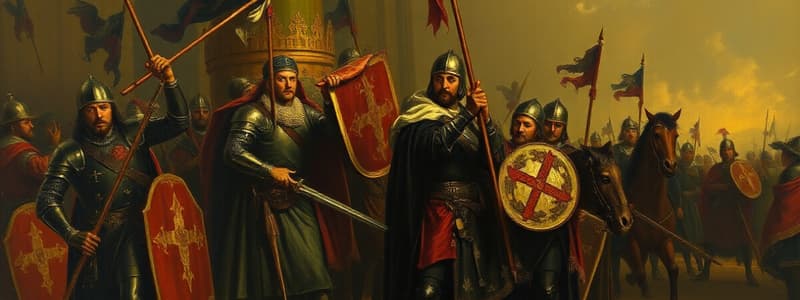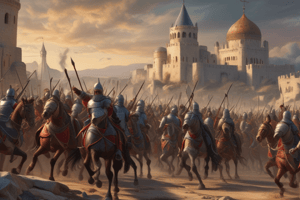Podcast
Questions and Answers
What was the primary motivation for the Crusades beyond religious reasons?
What was the primary motivation for the Crusades beyond religious reasons?
- To foster diplomatic relations with Muslim empires.
- To seek refuge from political instability in Europe.
- To establish new trade routes and accumulate wealth through eastward expansion. (correct)
- To study and adopt advancements in Islamic scholarship and technology.
Which request initiated the First Crusade?
Which request initiated the First Crusade?
- A call for help from Byzantine Emperor Alexius I to repel the Seljuk Turks. (correct)
- A plea from the Islamic Caliphate for assistance against nomadic tribes.
- A request from European merchants seeking safer trade routes through the Middle East.
- An invitation from Jerusalem's religious leaders to restore peace.
How did Pope Urban II incentivize participation in the First Crusade?
How did Pope Urban II incentivize participation in the First Crusade?
- By promising immediate forgiveness of sins, eliminating the need for indulgences or purgatory. (correct)
- By offering financial compensation to all who participated in the military campaigns.
- By granting land ownership in conquered territories to all Crusaders.
- By guaranteeing noble titles and elevated social status to returning Crusaders.
What event followed the Christian capture of Jerusalem during the First Crusade?
What event followed the Christian capture of Jerusalem during the First Crusade?
What was the composition of the states carved out by the Christians following the First Crusade, and who primarily surrounded them?
What was the composition of the states carved out by the Christians following the First Crusade, and who primarily surrounded them?
What was a significant difference between the First Crusade and the subsequent Second Crusade?
What was a significant difference between the First Crusade and the subsequent Second Crusade?
Why did the Fourth Crusade deviate from its original purpose of reconquering Jerusalem?
Why did the Fourth Crusade deviate from its original purpose of reconquering Jerusalem?
Which factor contributed most to the Crusaders' increasing difficulties and failures as the Crusades continued?
Which factor contributed most to the Crusaders' increasing difficulties and failures as the Crusades continued?
What was the long-term impact of the Crusades on feudalism in Europe?
What was the long-term impact of the Crusades on feudalism in Europe?
How did the outcome of the Sixth Crusade differ from that of the Fifth Crusade?
How did the outcome of the Sixth Crusade differ from that of the Fifth Crusade?
Flashcards
The Crusades
The Crusades
Holy wars between Muslims and Christians for control of religiously significant sites.
Christian Motives for Crusades
Christian Motives for Crusades
Eastward expansion driven by trade, wealth, and the spread of Christianity.
Holy Land Region
Holy Land Region
Egypt, Syria, Israel, and Turkey, with Jerusalem as the central objective.
Great Crusades
Great Crusades
Signup and view all the flashcards
First Crusade triggers
First Crusade triggers
Signup and view all the flashcards
First Crusade
First Crusade
Signup and view all the flashcards
Second Crusade
Second Crusade
Signup and view all the flashcards
Third Crusade
Third Crusade
Signup and view all the flashcards
Fourth Crusade
Fourth Crusade
Signup and view all the flashcards
Crusade
Crusade
Signup and view all the flashcards
Study Notes
- The Crusades were a series of holy wars between Muslims and Christians
- The wars were fought for control of holy sites important to both faiths
- Christians also had underlying motives for eastward expansion, trade route expansion, wealth increase, and spreading Christianity
- The Crusades primarily occurred in the Holy Land, including Egypt, Syria, Israel, and Turkey
- Jerusalem was the main objective to control
Great Crusades Timeline
- Historians generally agree on nine primary crusades, with the first four being the most impactful
- Crusades after the Fourth Crusade were minor and had little impact
- First Crusade: 1096-1099
- Second Crusade: 1145-1149
- Third Crusade: 1189-1192
- Fourth Crusade: 1202-1204
- Children's Crusade: 1212
- Fifth Crusade: 1217-1222
- Sixth Crusade: 1228-1229
- Seventh Crusade: 1248-1254
- Eighth Crusade: 1271
- Ninth Crusade: 1271-1272
First Crusade
- Pope Urban II blessed after Byzantine Emperor Alexius I requested help against the Seljuk Turks
- The Pope promised immediate forgiveness of sins to recruit more people
- People from all social classes participated, seeking atonement
- Crusaders motivated by God, glory, and gold
- Antioch was captured by the Christians
- Jerusalem fell to the Christians in 1099 after a massacre of Muslims
- Christians established four states in the area: Antioch, Edessa, Tripoli, and Jerusalem
- The First Crusade is considered the most successful and impactful, as Jerusalem was taken from the Muslims
Second Crusade
- Muslims began to resist and respond to calls for jihad
- Supported and led by Saint Bernard of Clairvaux, Louis VII of France, and Conrad III of Germany
- Started after Edessa was lost to the Turks
- Louis and Conrad joined forces at Jerusalem and invaded Damascus with 50,000 troops
- The Crusade was a complete failure, as Nur al-Din assisted the Muslim forces
Third Crusade
- Led by Frederick Barbarossa of Germany, Richard I the Lionheart of England, and Philip II Augustus of France
- Muslim leader Saladin was defeating Christian armies and added Cairo, Egypt, and Hattin to his territory
- Frederick Barbarossa drowned before reaching Syria
- Richard defeated Saladin at Arsuf
- European leaders captured coastal towns but could not break through Muslim forces to take Jerusalem
- Philip went home, and Richard negotiated a truce with Saladin, allowing Christian pilgrimages to Jerusalem
- The Third Crusade ended with nothing gained
Fourth Crusade
- Pope Innocent III called for another crusade to re-conquer Jerusalem after Saladin’s death in 1193
- Crusaders fought over the Byzantine throne
- Crusaders overthrew Alexius III for Alexius IV in 1203
- Alexius was killed in 1204
- Crusaders sacked Constantinople as a detour from the war against Muslims
- In 1261, the city was back under Byzantine control
- In 1453, the city was converted to a Muslim city when the Ottoman Turks sacked it
Fifth Crusade
- Led by Pope Innocent III and Andrew II of Hungary and Leopold VI of Austria
- Crusaders attacked Egypt from land and sea, facing resistance at Mansurah
- Crusaders surrendered to Al-Malik al-Kamil, Saladin's nephew
- Crusaders had to vacate Egypt and agree to an eight-year truce
- It ended in defeat for the Christians
Sixth Crusade
- Led by Frederick II to reclaim Jerusalem and the Holy Land
- Frederick II negotiated peace with al-Kamil in Arabic over Jerusalem
- Jerusalem transferred back to Crusader control but only lasted a decade
End of the Crusades
- Nine Crusades are the well known
- Seventh, Eighth, Ninth, and Children's Crusades were unsuccessful and short-lived
- Crusaders became less familiar with the language, culture, climate, and geography as the Crusades continued
- Seventh Crusade was organized by King Louis IX against Egypt, resulting in his capture and ransom
- Eighth Crusade was led by Louis with an attack in North Africa, but Louis died in 1270
- Ninth Crusade was led by Edward I of England, accomplishing little
Effects of the Crusades
- Persecution of the Jews
- Increased wealth in Italy
- Feudalism declined as people from all social classes went on Crusades
- Monarchs increased their power and landholding wealth
- New trading partners emerged in the East, bringing wealth and exotic goods
- The Pope's power diminished as the call for Crusades was misused for material and political gain
Studying That Suits You
Use AI to generate personalized quizzes and flashcards to suit your learning preferences.




